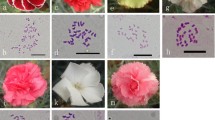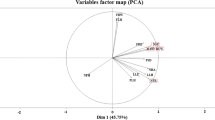Summary
Interspecific crosses of five cultivated cassava varieties (2n=36) were made with two related Manihot species, M. epruinosa (2n=36) and M. glaziovii (2n=36). From these diploid interspecific crosses, four spontaneous tetraploids (2n=4x=72) and two triploids (2n=3x=54) were isolated for the first time in cassava. Occurrence of relatively high frequencies (0.1%–35.6%) of 2n pollen and of apomixis seems to be associated with sexual polyploidization. The tetraploids and triploids were very vigorous and one of the tetraploids performed as well as the best variety in uniform yield trials conducted in Nigeria. These spontaneous polypoloids provide greater genetic variation and offer an opportunity to breed radically new cassava varieties. Approaches for isolating and utilizing the polyploid cassava clones for varietal and population improvement are discussed.
Similar content being viewed by others
References
Abraham A (1957) Breeding of tuber crops in India. Indian J Genet Plant Breed 17:212–217
Abraham A, Panicker PKS, Mathew PM (1964) Polyploidy in relation to breeding in tuber crops. J Indian Bot Soc 43:278–283
Allem AC (1984) A taxonomic revision of Manihot section Quinquelobae. PhD thesis, University of Reading
Allem AC, Hahn SK (1988) Cassava. Paper presented at the Workshop on Genetic Resources of Selected Crops in Africa. IITA, Ibadan, Nigeria, October 17–20
Bai KV (1987) Recent advances in cassava genetics and cytogenetics. In: Hershey CH (ed) Cassava breeding: a multidisciplinary review. Proceedings of a Workshop held in the Philippines, March 4–7, 1985, pp 35–49
Bai KV, Jos JS (1981) A simple and rapid method of screening stomatal distribution and trichomes in cassava. Curr Sci 50:773–774
Beck BDA (1982) Historical perspectives of cassava breeding in Africa. In: Root Crops in Eastern Africa. Proc of a Workshop held in Kigali, Rwanda, November 23–27, 1980. IDRC, Canada, pp 13–18
Clausen J (1947) Heredity of geographically and ecologically isolated races. Am Nat 81:114–133
Course G (1951) Le manioc à Madagascar. Mem Inst Sci Madagascar Ser B 3:203–400
Graner EA (1941) Polyploid cassava: Induced by colchicine treatment. J Hered 32:281–288
Hahn SK (1989) An overview of African traditional cassava processing and utilization. Outlook Agric 18:110–118
Hahn SK, Keyser J (1985) Cassava: a basic food of Africa. Outlook Agric 14:95–99
Hahn SK, Terry ER, Leuschner K (1980) Cassava breeding for resistance to cassava mosaic disease. Euphytica 29:673–683
IITA (1987) IITA annual report and research highlights, 1986, pp 91–92
IITA (1988) IITA annual report and research highlights, 1987/88, pp 122–125
Jennings DL (1963) Variation in pollen and ovule fertility in varieties of cassava, and the effect of interspecific crossing on fertility. Euphytica 12:69–76
Jos JS, Magoon ML, Nair SG (1970) A cytological and morphlogical analysis of triploid cassava. Genet Iber 22:27–39
Jos JS, Bai KV, Sreekumari MT (1987) Triploidy as a tool in cassava improvement. Proc Natl Symp Prod Utiliz Trop Tuber Crops held at CTCRI, Trivandrum, India, November 27–29, 1985, pp 7–13
Lathrap DW (1970) The upper Amazon. Thames and Hudson, London
Magoon ML, Jos JS, Appan SG (1966) Cytomorphology of the interspecific hybrid between cassava and ceara rubber. Chromosome Inf Svc Jpn 7:8–10
Magoon ML, Krishnan R, Bai KV (1969a) Morphology of the pachytene chromosomes and meiosis in Manihot esculenta Crantz. Cytologia 34:612–626
Magoon ML, Jos JS, Vasudevan KN, Nair SG (1969b) Cytomorphological studies on induced polyploids of cassava. Genet Iber 21:27–48
Mok DWS, Peloquin SJ (1975) Three mechanisms of 2n pollen formation in diploid potatoes. Can J Genet Cytol 17:217–227
Nichols RFW (1947) Breeding cassava for virus resistance. East Afr Agric J 12:184–194
Perry AB (1943) Chromosome number and phylogenetic relationships in the Euphorbiaceae. Am J Bot 30:527–543
Renvoize BS (1972) The area of origin of Manihot esculenta as a crop plant — a review of the evidence. Econ Bot 26:352–360
Rogers DJ, Appan SG (1973) Manihot and Manihotoides (Euphorbiaceae). Flora Neotropica Monograph 13. Hafner Press, New York
Stebbins GL (1950) Variation and evolution in plants. Columbia University Press, New York
Swaminathan MS, Magoon ML, Mehra KL (1954) A simple propiono-carmine PMC smear method for plants with small chromosomes. Indian J Genet 14:87–88
Umanah EE, Hartmann RW (1973) Chromosome numbers and karyotypes of some Manihot species. J Am Soc Hortic Sci 98:272–274
Author information
Authors and Affiliations
Additional information
Communicated by J. Mac Key
Rights and permissions
About this article
Cite this article
Hahn, S.K., Bai, K.V. & Asiedu, R. Tetraploids, triploids, and 2n pollen from diploid interspecific crosses with cassava. Theoret. Appl. Genetics 79, 433–439 (1990). https://doi.org/10.1007/BF00226148
Received:
Accepted:
Issue Date:
DOI: https://doi.org/10.1007/BF00226148




